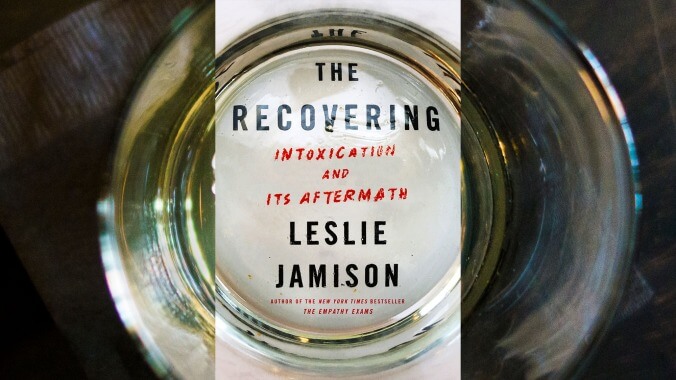Incisive and expansive, Leslie Jamison’s The Recovering is an addiction memoir for the ages

Hemingway in Cuba. John Cheever’s drunk swimmer. Carson McCullers’ gin and cigarettes diet. Writing and drinking have long intertwined in the cultural consciousness, often making legendary myths of artists with very real drinking problems. In her new critical memoir, The Recovering: Intoxication And Its Aftermath, Leslie Jamison examines the intersection of art and alcohol, and the stories we tell about addiction. Weaving in historical research and original reporting, she also traces her own alcoholism and subsequent recovery at the age of 27.
Like many suffering from substance abuse, Jamison was high-functioning throughout her addiction, and extraordinarily so: She graduated from Harvard; held down multiple jobs; and twice attended graduate school—first, the venerable Iowa Writers’ Workshop and then Yale. While avoiding the sensationalist, over-the-top details of lesser addiction memoirs like James Frey’s A Million Little Pieces, Jamison nonetheless makes palpable how strong her desire for alcohol was, with each day becoming a countdown to how quickly she could get drunk that evening. Although she cites a family history, a father who was often away, and a desire to escape “the endless chatter of [her] inner monologues and self-appraisals,” she refrains from getting mired in the armchair psychology of her motivations for drinking, understanding that such explanations are nearly always insufficient. “My childhood was easier than most,” she writes, “and I ended up drinking anyway.”
Jamison has proven herself to be both a fierce intellectual and an extreme empath. In her 2014 New York Times bestselling essay collection, The Empathy Exams, she often worked herself into near logical contradictions, resulting from a kind of head vs. heart dichotomy. In her essay on the controversial Morgellons disease, which involves thinking one’s skin is infected by insects or objects like thread, Jamison got as close as she could to believing the disease’s sufferers without directly affirming it. She performs similar moves in The Recovering while writing on her time in Alcoholics Anonymous, specifically regarding the power of language and storytelling. As a writer dedicated to specificity and uniqueness—the old modernist maxim to “make it new”—she at first resists the “one day at a time” clichés of AA. Yet she also understands how such timeworn language helps people, herself included:
In recovery, I found a community that [suggested] instead that a story was most useful when it wasn’t unique at all, when it understood itself as something that had been lived before and would be lived again. Our stories were valuable because of this redundancy, not despite it. Originality wasn’t the ideal, and beauty wasn’t the point.
One can acknowledge the triteness of “one day at a time,” while holding onto it like a buoy.
As powerful as they may be, clichés still dull the truth, sanding down its intricacies into a simpler and more immediately recognizable form. It’s partly for this reason that Jamison turns to the more complex literature of drinking. Here she admits to having glamorized literary heavyweights like Raymond Carver, Jean Rhys, and John Berryman. “I idolized the iconic drunk writers because I understood their drinking as proof of extreme interior weather,” she writes. “The appeal wasn’t just about intoxication—as a portal, or a bandage—but about the appealing relationship between creativity and addiction itself: its state of thrall, its signature extremity. The person who found himself in that state of thrall was someone who felt things more acutely than ordinary men, who shared his living quarters with darkness, and then eventually the drama of enthrallment became—itself—something worth writing about.”
The alcohol didn’t just intoxicate Jamison; its stories did, too, and her close reading of works like Good Morning, Midnight and Dream Songs is some of the book’s most thrilling writing. (It would not be surprising to see a renewed interest in Charles Jackson’s 1944 novel The Lost Weekend, for example, as a result of those passages.) As in The Empathy Exams, there is a dynamic energy between Jamison’s personal experiences and the texts she examines. These novels and stories and poems don’t just provide context; they also inform how she thinks about her own drinking.
As deftly as Jamison weaves her memoir’s various strands together, occasionally her extensive research slows the book down. The Recovering was born from the author’s English literature dissertation at Yale, and some sections feel like entries in an annotated bibliography, providing deep background reading rather than information essential to the work as a whole. To wit, the passages detailing the birth of the War On Drugs and the Narco Farm—a federal rehabilitation center opened in 1935 that was part prison, part hospital—could get to their salient points more quickly: namely, that America has long had trouble deciding whether to treat addicts as victims or criminals, and that the line is often drawn according to race, gender, and class. “When it comes to addiction,” Jamison writes, “the abstraction of privilege is ultimately a question of what type of story gets told about your body: Do you need to be shielded from harm, or prevented from causing it?”
The excess of these sections, however, seems part of the point. The book is, to use a hackneyed phrase, an outpouring. Addiction is messy and complicated, recovery just as much, and neither can be reduced to a single, simple story. Therein lies the kind of fruitful contradiction that Jamison embraces: She’s written a singular, extraordinarily insightful memoir of addiction, one which she might insist is altogether ordinary. That a reader might recognize herself in these pages, familiar as they are, is, of course, part of their power.